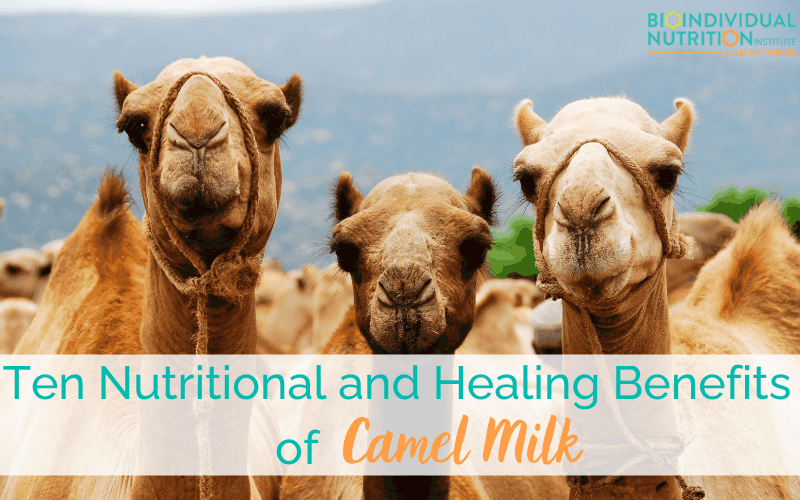
When to Add Camel Milk to
a Personalized Nutrition Plan
Camel milk is a wonderful healing food.
As a Certified Nutrition Consultant, I have been recommending it to my clients with autism (and practitioners in my BioIndividual Nutrition Training) for many years.
But early in my nutrition career, I was skeptical of camel milk … I was unconvinced that ANY milk would be different than cow, goat, or sheep milk.
… and even though raw milk and A2 β-casein milk are better and more nutritious than standard pasteurized milk, they are not much different protein wise – and won’t be tolerated by my most sensitive clients, namely, those with autism (and autoimmune conditions).
But camel milk is different. Here’s the latest on when to add camel milk to a personalized nutrition plan…
Why is Camel Milk So Different?
I believe it’s because camels withstand a harsh environment that most other animals do not, and I imagine they adapted to this to produce a milk like no other. Camels can live without water for 30 days, even without much food to eat, and their milk remains very high quality.
Camel milk has unique and amazing properties, including advantages for immune system and digestive system.
Here are ten nutritional and healing benefits of camel milk.
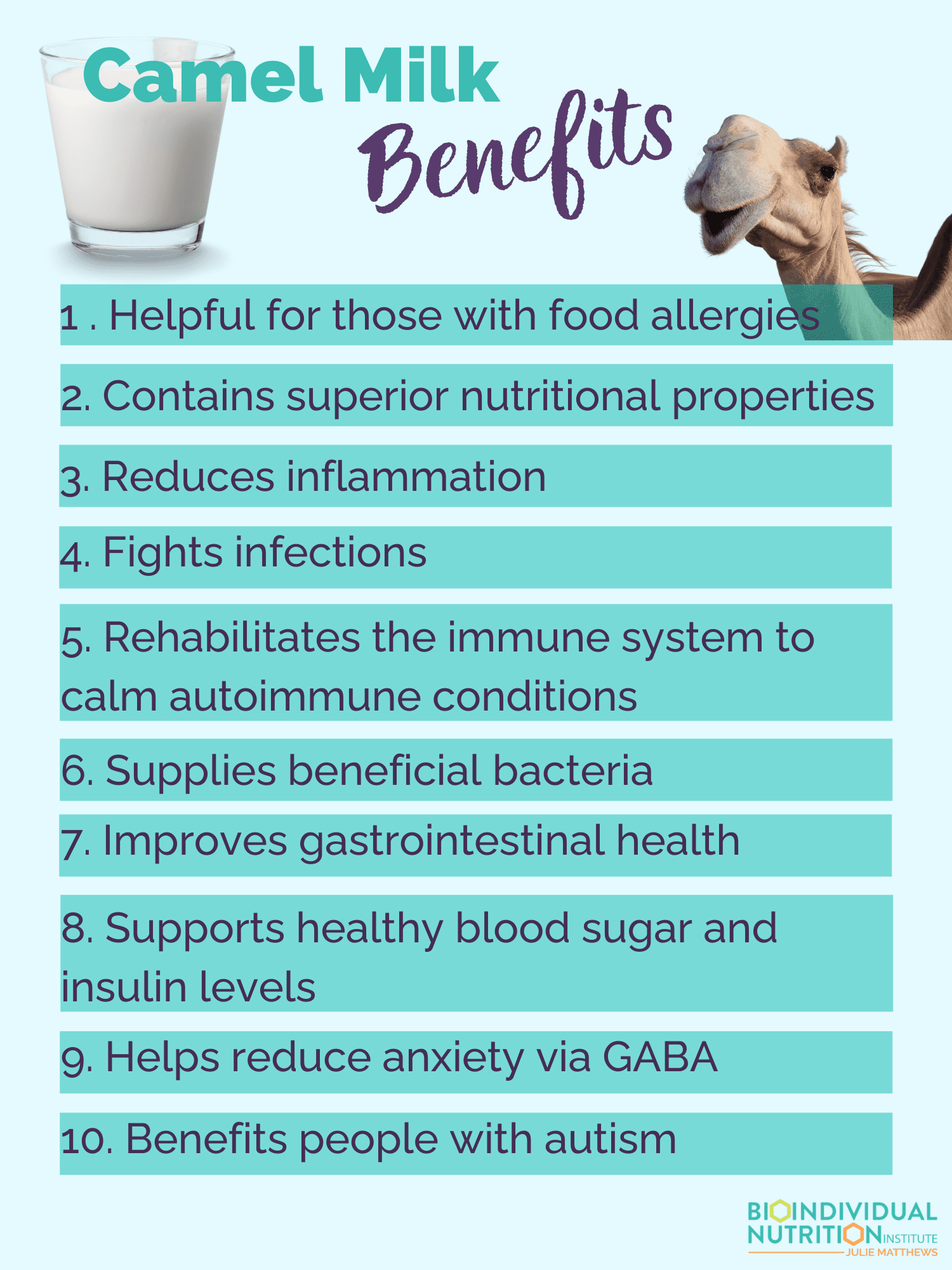
1) Camel Milk Is Helpful for Those With Food Allergies
Two important proteins related to animal milk allergies are β-lactoglobulin and casein.
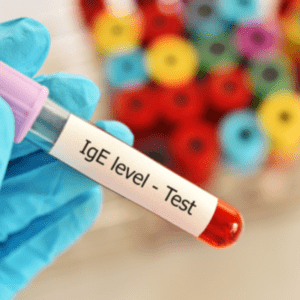 Camel milk does not contain β-lactoglobulin. [1] [2] So, those who react to cow or other mammal milk because they make antibodies to β-lactoglobulin usually do not react to camel milk.
Camel milk does not contain β-lactoglobulin. [1] [2] So, those who react to cow or other mammal milk because they make antibodies to β-lactoglobulin usually do not react to camel milk.
One study showed that, although children with IgE antibodies to cow-milk react to several mammal milks such as from goats and ewes, camel milk was not recognized by the immune system. [3] Children with severe food allergies seem to respond well to camel milk, and astonishingly, even fully recover from their milk allergies, as well as from allergies or sensitivities to other foods. [4] This was shown to be likely the case in about 80% of children with cow milk allergy.
Casein molecules are micelles (spherical in shape) and they are larger in size (15 nm) than cow milk or human milk. [5] Camel milk has a lower pH, so that when it enters the stomach, the casein micelles do not break down into casein and whey– therefore, they do not break into casomorphins.
Casomorphins are one of the big challenges associated with casein intolerance, as they cause opiate reactions and symptoms, as well as inflammation.
2) Camel Milk Contains Superior Nutritional Properties
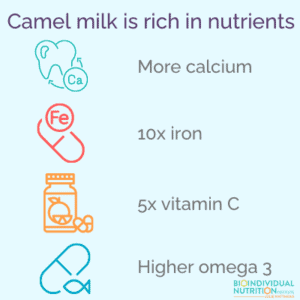 Camel milk is very nutritious. It contains 2% fat, and the fat molecules are joined to protein, hence there’s no added stress on the liver.
Camel milk is very nutritious. It contains 2% fat, and the fat molecules are joined to protein, hence there’s no added stress on the liver.
Camel milk has five times the amount of vitamin C than cow milk with 48 to 256 mg of vitamin C per liter, [6] 10x the iron of cow milk, and more calcium.
The fat of camel milk is high in polyunsaturated fatty acids, with a ratio of omega-3 to omega-6 that is higher than cow milk.
Camel milk is considered a complete food; in other words, it can be consumed exclusively and meet all needed nutritional requirements.
Traditionally, camel milk has been consumed raw and unpasteurized. And like most raw milk it appears to contain the most nutritional and immune properties in this form, since they are not destroyed by pasteurization. However, this has not been scientifically tested with vigor. A few small-scale, short-term studies have been conducted, with promising results, but long-term studies that are better designed to reduce bias are needed. [7] Until more conclusive data is gathered, drinking any form of camel milk should bestow at least some benefits. If the quality and safety of a raw milk source is in question, opt for pasteurized milk.
The superior nutritional properties of camel milk result in numerous positive health improvements, many of which are described in the following sections.
3) Camel Milk Reduces Inflammation
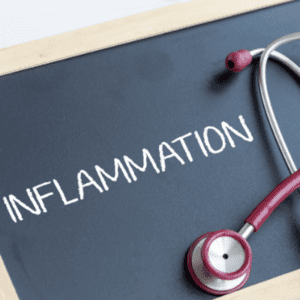 In addition to mitigating allergies, camel milk can reduce inflammation, which has long been touted anecdotally by fervent camel milk drinkers.
In addition to mitigating allergies, camel milk can reduce inflammation, which has long been touted anecdotally by fervent camel milk drinkers.
It has often been said that camel milk reduces inflammation in diabetes, as indicated by the reduced need (sometimes going to nil) for insulin. However, the mechanism for how camel milk may affect the inflammatory process had not been studied until recently, when the following preliminary research was done.
In one study, total lipids and total fatty acids were extracted from camel milk and preincubated with macrophage-like cells. [8] Then, the cells were challenged with glycated serum albumin, which induces the secretion of some proinflammatory cytokines. The lipid extractions from camel milk significantly reduced the secretion of the proinflammatory cytokines and increased the expression of some anti-inflammatory cytokines. The study also found that the total lipids in camel milk regulated the inflammasome, part of the innate immune system responsible for the activation of inflammation. This study demonstrates the ability of camel milk lipids to regulate inflammation.
4) Camel Milk Fights Infections
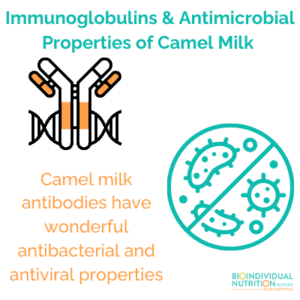 The antibodies, or immunoglobulins (Igs), within and the immune properties of camel milk contribute to its wonderful viral and bacterial fighting abilities.
The antibodies, or immunoglobulins (Igs), within and the immune properties of camel milk contribute to its wonderful viral and bacterial fighting abilities.
Camel milk has superior immune benefits.
The immunoglobulins as well as the protective proteins in camel milk contribute to camel milk’s amazing ability to help fight infections.
Since camel milk immunoglobulins are only 1/10 the size of human immunoglobulins they can penetrate into cells and tissues in a way that human immunoglobulins are not able to. Therefore, they are able to get into the kidney or inside a cell, where they are able to neutralize the enzyme activity of a pathogen such as a bacteria or virus.
Camel milk also contains immunoglobulins that are unique to camels, including special IgG2 and IgG3 subclasses. The immunoglobulins in these two subclasses are shaped like Ys as human immunoglobulins are, but they are missing the sections called light chains. Yet, the functional sections of these IgGs work just as well as the normal IgGs containing the light chains. The lack of the light chains makes the IgG2 and IgG3 subclasses about 60% the size of the normal IgG molecules. [9] Because they are smaller, they can better penetrate into tissues and organs to fight infection and aid repair, where human antibodies cannot.
Camel antibodies have wonderful antibacterial and antiviral properties. In Dr. Reuven Yagil’s paper on camel milk and autoimmune diseases he explains how conventional antibodies rarely have full neutralizing activity against enzyme antigens while, “camel IgG has a full neutralizing activity against tetanus toxin as it enters the enzymes structure”. [10] Viruses can also be neutralized by inhibiting their enzyme activity, and research shows that camel antibodies are an effective inhibitor against the hepatitis C enzyme system. [11]
In a study on the use of camel milk for autism, the author compares camel milk to intravenous immunoglobulin therapy describing that it acts as a natural immunoglobulin therapy, where effects continue after the therapy is stopped, because of the immune-rehabilitating action. [12]
Camel milk contains the following immune proteins:
- Lactoferrin is found in higher concentrations in camel milk than in cow and goat milks. Lactoferrin prevents microbial overgrowth and pathogen invasion.
- Peptidoglycan recognition protein (PGRP) is very high in camel milk. This protein stimulates the host’s immune response and has antimicrobial activity. In studies it even appears to have an effect on breast cancer.
- Lactoperoxidase has bacteria-killing effects on gram-negative bacteria such as Escherichia coli (E. coli), Salmonella, and Pseudomonas. It also has antitumor activity.
- Lysozyme, an enzyme that is part of the innate immune system, is found in camel milk and it targets gram-positive bacteria.
- N-acetyl-beta-D-glucosamidase (NAGase), which is also found in human milk in similar quantities has antibacterial activity.
5) Camel Milk Rehabilitates the Immune System to Calm Autoimmune Conditions
Camel milk is particularly helpful in addressing immune system dysregulation in various forms. It can support people with autoimmune conditions and help them heal.
One theory about autoimmune disease is that the body attacks itself because it’s trying (in vain) to get at bacteria buried in body tissue. Camel milk’s antibacterial activities and special immune response allow camel milk antibodies to penetrate into body tissues when the “quiet” bacteria turn pathogenic. Because the antibodies are able to get into the affected tissue to attack the infectious agent (for example, the saprophyte bacteria found in Crohn’s disease), it is theorized that camel milk can help someone heal in ways not seen through any other intervention—dietary or otherwise.
Because camel milk is nourishing and easy to digest, it does not trigger allergenic or opiate responses and helps heal the gut and infections, protecting and enhancing the immune system.
6) Camel Milk Supplies Beneficial Bacteria
As those in science and medicine try to increase their understanding of the different microbiomes in humans and other organisms, study of beneficial bacteria is continual. For example, researchers in China isolated roughly 100 strains of lactic acid bacteria (LAB) from Mongolian camel milk. [13]
LAB are known for balancing intestinal microbiota. The strains were screened for probiotic activity, then the hardiest were tested to see if they afforded protection against acute liver injury. The liver enzymes aspartate aminotransferase (AST) and alanine aminotransferase (ALT) and the proinflammatory cytokines IL-6 and TNF-α were monitored after pretreatment with the LAB and subsequent acute liver injury. The experimental animals given the LAB strains had significantly lower levels of the liver injury indicators monitored.
The potential to find more bacteria in camel milk that boost health is very high.
7) Camel Milk Improves Gastrointestinal Health
Camel milk has wonderful gastrointestinal health and healing benefits.
The protective proteins we discussed earlier, lactoferrin, peptidoglycan recognition protein, lactoperoxidase, and lysozyme have antibacterial and anti-diarrheal properties.
These antibacterial properties, along with the very small size of the immunoglobulins discussed earlier that can penetrate into the affected tissue and combat the pathogen in the gastrointestinal tract, help improve digestive health and aid healing.
Camel milk also has high titers of antibodies against rotavirus, a common cause of diarrhea, especially in children under 5 years old. Because of these anti-rotavirus antibodies, camel milk can help improve diarrhea. According to Dr. Yagil, camel milk has been used for centuries to treat diarrhea. [14]
8) Camel Milk Supports Health Blood Sugar and Insulin Levels
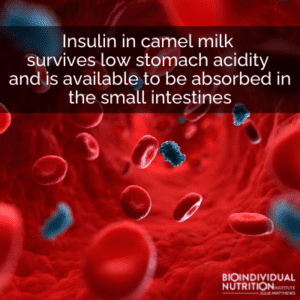 Camel milk contains insulin and is effective in diabetes, [15] including gestational diabetes. [16]
Camel milk contains insulin and is effective in diabetes, [15] including gestational diabetes. [16]
A review of research on the effects of camel milk on diabetes concluded that camel milk can lower blood glucose levels, dependence on insulin, and other complications of diabetes. [17] Camel milk itself is acidic, so its insulin survives low stomach acidity and does not coagulate, as other oral insulins do. The camel insulin is then available and able to be absorbed in the small intestines.
It is thought that the protective proteins mentioned in Section 4 also survive the hostile stomach environment and help reduce inflammation, which is involved in diabetes. [18] Thus, multiple mechanisms likely exist for the beneficial effects of camel milk on diabetes.
9) Camel Milk Helps Reduce Anxiety Via GABA
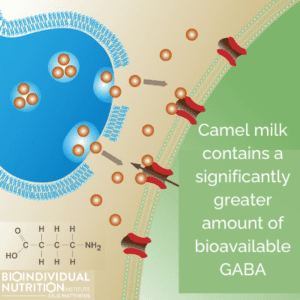 The inhibitory neurotransmitter, gamma-aminobutyric acid (GABA), is thought to play a role in anxiety, although the mechanism for such is not entirely known yet. GABAergic deficits are found in several behavioral conditions, and agents that affect GABA receptors are used to treat anxiety.
The inhibitory neurotransmitter, gamma-aminobutyric acid (GABA), is thought to play a role in anxiety, although the mechanism for such is not entirely known yet. GABAergic deficits are found in several behavioral conditions, and agents that affect GABA receptors are used to treat anxiety.
Researchers found that camel milk contains a significantly greater amount of bioavailable GABA than cow or, even human, milk does. [19] This corresponds to the general feeling of health and well-being usually attributed to drinking camel milk. Camel milk was able to activate GABAρ receptors. These receptors are present in the brain and other tissues, which could explain the effect of GABA on mood.
Incidentally, as all the effects of GABA have yet to be discovered, several other benefits have been hypothesized through the GABAergic effects of camel milk. Researchers found that camel milk helped delay the start of and reduce the severity of convulsions in an animal model. [20] Camel milk has been shown to help with diabetes and cancer, with some believing it’s through the GABAergic effect.
10) Camel Milk Aids People with Autism
Children with autism routinely have immune system challenges, such as the inability to fight bacterial, viral, and other infections as well as states of chronic inflammation, and allergy. For them, camel milk seems promising, as it often has health and healing benefits.
As mentioned in Section 1, camel milk caseins do not break down into casomorphins. Casomorphin creation from cow milk consumption is a common pathway leading to autism symptoms. Removing cow milk often helps decrease these symptoms greatly. Using camel milk as a substitute dairy source provides nutritional and healing benefits, as discussed in the sections above.
Additionally, autism, or at least a subset of autism, appears to be an autoimmune condition. With the ability for camel milk to help rehabilitate the immune system for people with autoimmune conditions, camel milk seems to have additional benefits for improving autism.
Clinical Case Studies With Camel Milk For Autism
The results published in a paper by Shabo and Yagil (2005) on camel milk for autism were very positive. [21]
The researchers lay out several case studies out of dozens with similar experiences. They include:
A 4-year old girl who had suffered from periods of severe rage, she was a picky-eater, had no eye contact, and no communicative skills was considered normal after only 40 days of drinking camel milk. She became calm, ate a varied diet, began talking, wanted hugs, and was working on a computer.
A 15-year old boy with serious symptoms of autism (similar to those of the 4 year old girl) and also suffering from enterocolitis, showed improvement in cognition and communication within a month after beginning drinking camel milk.
Christina Adams’ son was diagnosed with autism when he was 3 years old. [22] He started taking raw camel milk that had been frozen and shipped from overseas, starting with ½ cup per day. Adams noted improvement immediately and recorded her observations and trials with camel milk for the next 6 years. When camel milk was consumed regularly, the child improved in behavioral, psychological, and physical ways. During a couple-week break from camel milk, many previously resolved and improved issues related to Autism Spectrum Disorder (ASD) returned, only to disappear or improve again when camel milk dosing was restored.
Practitioner Considerations
Cerebral Folate Deficiency (CFD)
While many parents report great results with camel milk, caution with regards to cerebral folate deficiency (CFD), a condition of below normal levels of folate in the central nervous system, is warranted. Folate receptor protein α (FRA) transports folate in the central nervous system. Dr. Edward V. Quadros, a researcher in FRA, has found folate receptor alpha antigen is very similar to cow’s milk, as well as the cross reactivity with the folate receptor alpha. Camel milk appears to be the same. In light of this, for children who produce autoantibodies to FRA camel milk seems to be contraindicated and may need to be avoided.
However, because the benefits generally are so high, some parents and practitioners feel it’s worth it to try camel milk at an extremely low amount (such as a drop on the skin, then a drop on the tongue, etc.) and monitor any reaction closely. [23] Some FRA-positive individuals have reported doing well on camel milk.
Galactosemia
Galactosemia is a rare genetic disorder that compromises how an individual metabolizes the monosaccharide galactose. Galactose is present in many foods, especially dairy foods. Newborns are screened for this rare disease during standard newborn blood testing. If a person tests positive for galactosemia, they should avoid all milk products. This is especially true for camel milk because it has one of the highest concentrations of galactose of the commonly consumed animal milks. [24]
Altered Drug Metabolism
Because of the range of effects of camel milk on the body, some researchers and practitioners wondered how it may affect the processing of other materials, such as prescription drugs and supplements.
Ibrahim and colleagues studied the effect of raw camel milk on several of the drug-metabolizing cytochrome P450 (CYP450) enzymes in rats. [25] CYP450s are a large class of enzymes that metabolize a wide variety of substrates, such as toxins and drugs. The researchers found that all four CYP450 enzymes that they looked at were downregulated. Thus, camel milk had an effect on how the substrates of those enzymes were processed.
Several practitioners have noted in particular that normal doses of dental and medical anesthesia have worn off too quickly in patients taking camel milk. [26] This is both alarming and promising, as camel milk can help clear both harmful and beneficial substances. Careful observation should occur whenever substances processed by such enzymes is happening. Only a handful of CYP450s have been studied against camel milk, thus the effects of camel milk on most substances is still unknown.
Milk Allergies
Those with allergies to other milks should be extremely cautious, and be monitored in a medical setting with their doctor.
How Much to Give
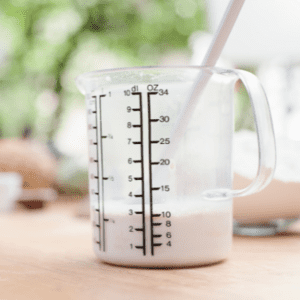 It’s important to start with a very low dose of camel milk and gradually ramp up to a maintenance dose. This avoids overloading the system with excess die-off materials (Herxheimer reaction) because of the antibacterial, antiviral, and antifungal properties of the milk.
It’s important to start with a very low dose of camel milk and gradually ramp up to a maintenance dose. This avoids overloading the system with excess die-off materials (Herxheimer reaction) because of the antibacterial, antiviral, and antifungal properties of the milk.
Dosing is not one-size-fits-all and depends a lot on an individual’s unique situation. Their body weight, type and severity of illness, diet, age, etc. must all be factored in.
A low starting dose generally is between 1 teaspoon to 2 tablespoons once a day. It is important to monitor the body’s reactions to the milk very closely. As long as things are improving and not regressing, the dose can be increased every 2–5 days. Typical maintenance dosing falls between 4 to 8 ounces.
However, the key is finding the sweet spot for each individual. Those with severe issues may only be able to tolerate a low dose for some time, while their bodies start healing. As the healing progresses, more and more milk should be tolerated, allowing the healing to proceed more quickly.
Where to Find It
 As camel milk is a relatively new product in the U.S., its commercial platform is still rapidly evolving. Currently, raw camel milk cannot be shipped across state lines. [27] However, in 30 U.S. states, raw milk can be sold within the state through a few different processes. Fortunately, the FDA says it will not enforce action against individuals who buy and transport raw milk across state lines, as long as the product is used personally. [28] So, if you can’t get raw milk in your state, but live close to one where it’s allowed, you can travel to that state and bring it back with you for your own use.
As camel milk is a relatively new product in the U.S., its commercial platform is still rapidly evolving. Currently, raw camel milk cannot be shipped across state lines. [27] However, in 30 U.S. states, raw milk can be sold within the state through a few different processes. Fortunately, the FDA says it will not enforce action against individuals who buy and transport raw milk across state lines, as long as the product is used personally. [28] So, if you can’t get raw milk in your state, but live close to one where it’s allowed, you can travel to that state and bring it back with you for your own use.
Camel dairies and farms exist in several states, so the best option for raw milk is to check local sources first. The purchase method will vary by state. However, the right to sell raw milk has been a hotbed of debate nationwide for many years. So, please check state regulations before buying anything.
Here are a few farms that currently have raw milk.
If local sources of raw milk are not available or pasteurized milk is preferred, several companies and farms sell pasteurized milk nationwide.
- Camelot Camel Dairy: flash pasteurized at 163 °F for 15–30 seconds, cooled quickly to 40–45 °F, and shipped frozen
- Desert Farms: low-temperature pasteurized at 145 °F for 30 minutes, quickly cooled, and shipped either fresh or frozen
- The Camel Milk Company: flash pasteurized at 163 °F for 15–30 seconds, cooled quickly to 40–45 °F, and shipped frozen
When liquid milk is not manageable because of financial, consumption, or other limitations, powdered or freeze-dried milk is another option.
- Camilk Dairy: freeze-dried powder
- Desert Farms: freeze-dried powder
- DromeDairy: “swift, yet precise pasteurization process” and spray-dried powder
- Sahara Dairy Company: powder that is flash pasteurized at 72 °C for 15 seconds and freeze dried
Conclusion
While everyone is different, and not everyone will tolerate camel milk, I do believe the healing benefits are vast. And I think camel milk has a wonderful place in many personalized, bioindividual nutrition plans.
Considering the unique qualities and the potential of camel milk, the range of maladies that it may help address seems wide. The positive reports from parents, individuals, and clinicians are exciting—camel milk holds great promise, and future study and clinical experience will be valuable. Because of the experiences of parents and professionals such as Dr. Yagil, I am intrigued and enthused about the value and healing properties of camel milk for people with a wide variety of health conditions.
I had the honor of communicating and sharing ideas with Dr. Yagil, and I want to take this moment to acknowledge his great contribution to the field of camel milk.
References
- Beg, Obaid Ullah, Hedvig von Bahr-Lindström, Zafar H. Zaidi, and Hans Jörnvall. “Characterization of a camel milk protein rich in proline identifies a new β-casein fragment.” Regulatory peptides 15, no. 1 (1986): 55-61.
- Hinz, Katharina, Paula M. O’Connor, Thom Huppertz, R. Paul Ross, and Alan L. Kelly. “Comparison of the principal proteins in bovine, caprine, buffalo, equine and camel milk.” Journal of Dairy Research 79, no. 2 (2012): 185-191.
- Restani, P., A. Gaiaschi, A. Plebani, B. Beretta, G. Cavagni, A. Fiocchi, C. Poiesi, T. Velona, A. G. Ugazio, and C. L. Galli. “Cross-reactivity between milk proteins from different animal species.” Clinical and experimental allergy: journal of the British Society for Allergy and Clinical Immunology 29, no. 7 (1999): 997-1004.
- Shabo, Yosef, Reuben Barzel, Mark Margoulis, and Reuven Yagil. “Camel milk for food allergies in children.” IMAJ-RAMAT GAN- 7, no. 12 (2005): 796.
- KAPPELER, STEFAN, ZAKARIA FARAH, and ZDENKO PUHAN. “Sequence analysis of Camelus dromedarius milk caseins.” Journal of Dairy Research 65, no. 2 (1998): 209-222.
- Konuspayeva, Gaukhar, Bernard Faye, and Gérard Loiseau. “Variability of vitamin C content in camel milk from Kazakhstan.” (2011).
- Mihic, Tamara, Daniel Rainkie, Kyle John Wilby, and Shane Ashley Pawluk. “The therapeutic effects of camel milk: a systematic review of animal and human trials.” Journal of evidence-based complementary & alternative medicine 21, no. 4 (2016): NP110-NP126.
- Al-Nasseri, Raya Hamdan, Huda Al-Ruqashi, Jamal Al-Sabahi, Ahmed Al-Harrasi, Ara Kenekanian, Yaj Banerjee, Keith Morris, and Nurudeen Hassan. “Lipids derived from Camel milk regulate NLRP3 inflammasome-dependent inflammatory responses in human macrophages.” Functional Foods in Health and Disease 9, no. 4 (2019): 224-240.
- Hamers-Casterman, C. T. S. G., Touriya Atarhouch, Set al Muyldermans, G. Robinson, C. Hammers, E. Bajyana Songa, N. Bendahman, and R. Hammers. “Naturally occurring antibodies devoid of light chains.” Nature 363, no. 6428 (1993): 446-448.
- Yagil, Reuven. “Camel milk and autoimmune diseases: historical medicine.” (2004).
- Martin, F., C. Volpari, C. Steinkuhler, N. Dimasi, M. Brunetti, G. Biasiol, S. Altamura, R. Cortese, R. De Francesco, and M. Sollazzo. “Affinity selection of a camelized V (H) domain antibody inhibitor of hepatitis C virus NS3 protease.” Protein Engineering 10, no. 5 (1997): 607-614.
- Shabo, Yosef, and Reuven Yagil. “Etiology of autism and camel milk as therapy.” International Journal on Disability and Human Development 4, no. 2 (2005): 67-70.
- Xu, R. H., L. Xiu, Y. L. Zhang, R. P. Du, and X. Wang. “Probiotic and hepatoprotective activity of lactobacillus isolated from Mongolian camel milk products.” Beneficial microbes 10, no. 6 (2019): 699-710.
- Yagil, Reuven. “Camel milk and its unique anti-diarrheal properties.” Isr Med Assoc J 15, no. 1 (2013): 35-6.
-
Agrawal, R. P., R. Beniwal, S. Sharma, D. K. Kochar, F. C. Tuteja, S. K. Ghorui, and M. S. Sahani. “Effect of raw camel milk in type 1 diabetic patients: 1 year randomised study.” Journal of camel practice and research 12, no. 1 (2005): 27.
- Yagil, Dr. Reuven, Dr. Brian Bressler, and Dr. Michael Mandi. 2011. Camel Milk for Health. 02 09. https://www.camelmilkforhealth.com/symposium.php.
- Shori, Amal Bakr. “Camel milk as a potential therapy for controlling diabetes and its complications: A review of in vivo studies.” Journal of food and drug analysis 23, no. 4 (2015): 609-618.
- Mirmiran, Parvin, Hanieh-Sadat Ejtahed, Pooneh Angoorani, Fariba Eslami, and Fereidoun Azizi. “Camel milk has beneficial effects on diabetes mellitus: A systematic review.” International journal of endocrinology and metabolism 15, no. 2 (2017).
- Limon, Agenor, Jose-Luis Gallegos-Perez, Jorge M. Reyes-Ruiz, Mohammad A. Aljohi, Ali S. Alshanqeeti, and Ricardo Miledi. “The endogenous GABA bioactivity of camel, bovine, goat and human milks.” Food chemistry 145 (2014): 481-487.
- Khatoon, Humera, Rahila Najam, Talat Mirza, Bushra Sikandar, Humera Ishaq, and Humera Anser. “Evaluation of anticonvulsant and neuroprotective effects of camel milk in strychnine-induced seizure model.” Asian Pacific Journal of Tropical Disease 5, no. 10 (2015): 817-820.
- Shabo, Yosef, and Reuven Yagil. “Etiology of autism and camel milk as therapy.” International Journal on Disability and Human Development 4, no. 2 (2005): 67-70.
- Adams, Christina M. “Patient report: autism spectrum disorder treated with camel milk.” Global advances in health and medicine 2, no. 6 (2013): 78-80.
- Smeltzer, B. (2017). The medical benefits of camel’s milk [PowerPoint slides]. Autism One.
- Abbas, Hayam M., Afaf O. Ali, Jihan M. Kassem, and Wafaa M. Zaky. “Evaluation of different types of Egyptian milk from biochemical aspects.” Int. J. Dairy Sci 12, no. 2 (2017): 130-136.
- Ibrahim, Zein Shaban, Mohamed Mohamed Ahmed, Samir Ahmed El-Shazly, and Mohamed Elsayed Alkafafy. “Effects of camel milk on drug metabolising cytochrome p450 enzymes expressions in rats.” Journal of Camel Practice and Research 23, no. 1 (2016): 25-32.
- Camel Milk USA. (n.d.). Warning: Camel milk and anesthesia. Camel Milk USA. Retrieved October 2, 2020, from
- U.S. Food and Drug Administration. (2017). Grade “A” pasteurized milk ordinance (Grade “A” PMO), 2017 revision. U.S. Department of Health and Human Services.
-
U.S. Food & Drug Administration. 2017. U.S. Food & Drug Administration. 11 23. https://www.fda.gov/food/buy-store-serve-safe-food/food-safety-and-raw-milk.



